Abstract
The global focus on geopolymer binder production has increased due to the adoption of waste materials and industrial byproducts. Given the gradual decline in the availability of fly ash and ground granular blast furnace slag (GGBFS) resulting from the decarbonization process in electricity and steel production, waste clay brick powder (WCBP) could be a viable substitute for these pozzolanic by-products. This study presents the economic and environmental benefits of the use of WCBP as a replacement for conventional pozzolanic by-products in geopolymer binder production by assessing its techno-eco-efficiency, environmental impact, and cost-effectiveness performances. The favorable mechanical characteristics exhibited by the fly ash–GGBFS–WCBP-based geopolymer binder emphasize the importance of assessing its sustainability alongside its technical viability. The study employed life cycle analysis (LCA), following ISO framework, and using the Simapro software 9.2, to evaluate the environmental implications of the use of WCBP-based geopolymer mixtures. Human toxicity emerged as the primary impact. Moreover, the analysis of life cycle costs highlighted key financial factors, with around 65–70% attributed to alkaline activators of the total cost. The production of alkaline activators was identified as a critical point for both environmental impact and economic considerations due to energy consumption. While WCBP-rich samples exhibit a 1.7–0.7% higher environmental impact compared to the control mix (CM), their high mechanical strength and cost-effectiveness make them technologically and economically efficient geopolymer mixes. In conclusion, the portfolio analysis for techno-eco-efficiency affirms that mixes containing 40%, 30%, and 20% WCBP are more efficient than those using 10% and 0% WCBP, respectively.
1. Introduction
The construction sector contributes significantly to the socioeconomic progress of a nation resulting from human and economic growth that requires improved housing conditions and civil infrastructure. The construction industries are heavily reliant on the use of cement, which is widely manufactured, and its production causes significant environmental impacts [1]. Cement is produced from the calcination of limestone, which releases a substantial amount of carbon dioxide, and the production process is energy-intensive [2]. Resource extraction such as limestone and the associated waste generation during production also impact the ecosystem. To address these challenges, the industry is exploring the use of alternative fuels in cement production and environmentally friendly cementitious materials.
Geopolymers presents a promising solution to address the environmental concerns associated with cement production [3]. Unlike conventional cement manufacturing, geopolymers do not rely on the carbon- and energy-intensive calcination process. Instead, geopolymers utilize industrial by-products like fly ash or slag, which reduces the reliance on virgin materials for cement production and so mitigates the environmental impact by using recycled waste materials. Geopolymer production involves an alkaline activation process that reacts with these by-products to produce a binder similar to traditional cement [4]. This process requires less energy and may significantly reduce the carbon footprint associated with the manufacturing of cementitious binders. Alternatively, it diverts the industrial byproducts from the residue areas, which avoids land use changes.
A range of industrial by-products and mineral deposits, like metakaolin, fly ash, GGBFS, ferronickel slag, and ultrafine slag, have been used as geopolymer precursors. Among these materials, fly ash is particularly noteworthy for its wider availability and its high silica (SiO2) and alumina (Al2O3) content, exceeding 70% [5]. Fly ash is often combined with various industrial by-products, such as GGBFS, to improve both the fresh and hardened properties of the geopolymer binder. The combination of fly ash and GGBFS in geopolymers demonstrated excellent mechanical and durability properties [6]. GGBFS, characterized by its high calcium content, complements the very low calcium content of fly ash when they are used together as binary precursors. When curing at room temperature, GGBFS contributes to improved mechanical and microstructural properties due to its elevated calcium content and enhances binding properties when activated by an alkali [6]. By replacing silicon-rich materials with a low calcium content with a small proportion of GGBFS, the setting time can be reduced and mechanical properties in both the early and later stages of geopolymer development can be enhanced [6].
The production of fly ash, a by-product from coal combustion, has been gradually decreasing due to several factors. The shift towards decarbonization processes, such as natural gas and renewable energy, will gradually reduce the reliance on coal-fired power plants [7], which will result in the decrease in fly ash generation. Additionally, advancements in pollution control technologies in these plants have resulted in the reduction in fly ash generation. Furthermore, as a part of the decarbonization process, the iron production process is switching from blast furnaces to electric arc furnaces, which will result in the reduction in GGBFS [8]. As a result, it is crucial to discover a substitute material for these industrial byproducts with high pozzolanic properties to produce geopolymer binders. The solution lies in the waste that is generated within the construction industry.
Globally, approximately 25–30% of the solid waste generated is attributed to the construction industry, posing an escalating threat to the environment in recent times [9]. Australia’s construction industry contributes to a substantial portion of the waste annually (i.e., 76 million tons). Despite a relatively higher recovery rate within the sector, about 24% of the total construction waste remains unrecycled, leading to landfill disposal [10]. For every AUD 1 million contributed to the economy, the construction sector produces about 87 tons of waste, which could be eco-efficient [11]. The expenses allocated to waste services have surged since 2016, now exceeding AUD 17 billion annually, with AUD 2 billion attributed to the construction industry. This increase, amounting to a 35% rise since 2016–2017, underscores the concerns regarding the annual growth of waste production [11].
The bulk of waste, around 80%, generated from construction and demolition waste consists of concrete and brick waste [12]. Recycling this concrete and brick waste in concrete production not only alleviates waste disposal issues but also decreases the construction industry’s reliance on natural raw materials. Currently, researchers have made significant strides in utilizing recycled concrete aggregate and are initiating large-scale recycling efforts [13,14,15]. Regarding brick waste utilization, the usual practice involves crushing it and then utilizing it as a fractional replacement for fine or coarse aggregates in concrete. Limited research has explored the utilization of this brick waste in the creation of geopolymer binders [16]. To address this research void, the authors previously examined the integration of waste clay brick into geopolymer binders as a partial substitute for fly ash. However, it is crucial to assess the environmental sustainability and techno-eco-efficiency level, along with the technical feasibility, to validate the geopolymer mix design employed in our prior study.
Salas et al. [17], Kastiukas et al. [18] and Kul et al. [19] demonstrated that geopolymer binders offer a more sustainable and environmentally friendly alternative to conventional cement, contributing to the reduction in greenhouse gas emissions by 27–64%. However, Yoris-Nobile et al. [20] argued that geopolymer mortars have a higher environmental impact than low-clinker cement mortars due to their use of energy-intensive sodium hydroxide. Bajpai et al. [21] found alkaline activators to be the major sources of high environmental impacts for geopolymer binders. Additionally, Abbas et al. [22] found that sodium silicate contributed to a high environmental impact in geopolymer concrete. Life cycle assessment has been undertaken widely as a sustainability assessment tool for civil and construction engineers [23].
Amari et al. [24] discovered that incorporating mining waste streams and GGBFS into geopolymer production enhances the mechanical behavior of these hybrid geopolymers, achieving a maximum strength of 40 MPa while also reducing the life cycle environmental impact by 40% compared to ordinary cement, highlighting the environmental benefits of geopolymer materials. Gopalakrishna et al. [25] exposed that the geopolymer binder has significantly lower values of embodied energy and global warming potential compared to the OPC-based mortar, with reductions of 94% and 97%, respectively. In contrast, despite the favorable characteristics of geopolymer binders, Raza et al. [26] found that while hybrid cement mortars outperformed geopolymers in most impact categories in a life cycle analysis, the overall environmental impact assessment using the ‘coefficient of performance’ indicated that hybrid cement mortars have a significantly lower environmental burden than geopolymers. Gopalakrishna et al. [27] conducted both durability performance and LCA analysis for the German specifications of geopolymer concretes based on recycled aggregate, fly ash and GGBFS and concluded that the recycled aggregate geopolymer concretes had an embodied energy of 4.48% and a global warming potential of 0.083, both markedly lower than conventional concrete. In a comparative LCA study, Ricciotti et al. [28] demonstrated that the production processes of porcelain stoneware-based products with geopolymer mortars made from waste materials can reduce energy use compared to other methods, making them environmentally and economically beneficial. Miyan et al. [29] discovered that incorporating recycled waste concrete powder consistently decreased the carbon emissions, cumulative energy demand, and cost of the resulting geopolymer mixes. Additionally, Occhicone et al. [30] emphasized the need for the use of LCA and life cycle costing analyses along with the structural analysis for geopolymer binders. These analyses provide valuable insights into the environmental impacts and cost-effectiveness of geopolymer materials, highlighting the need for a comprehensive approach in evaluating their suitability for future construction applications.
Nevertheless, only a few studies [31,32,33] have conducted LCA for geopolymer binders based on WCBP. Migunthanna et al. [31] performed LCA, comparing the environmental impact of conventional cement-based concrete and geopolymer concrete in rigid pavement construction, assessing CO2 emissions and energy consumption across different stages. The substitution of conventional concrete with geopolymer binders resulted in a nearly 50% reduction in total CO2 emissions and a 72% decrease in energy consumption. This study used waste clay bricks, slag, and fly ash as precursors, with anhydrous sodium silicate as the activator, to produce one-part geopolymer concrete. Mir et al. [32] performed LCA using GaBi software and followed the ISO 14040-44 guidelines [34] to assess the environmental implications of the use of geopolymers made from red brick waste and red ceramic waste. This study considered three optimized mixtures and curing methods for assessing environmental impacts including global warming potential (GWP), eutrophication potential (EP), ozone depletion potential (ODP), and acidification potential (AP), among others. In Phase I, using a binary composition, sodium silicate and electricity made significant contributions to the environmental consequences. In Phase II, a ternary mixture was observed that slightly increased the use of sodium silicate but exhibited lower overall environmental effects compared to binary compositions. In Phase III, similar environmental performance to Phase I was observed, a producing higher GWP from additional curing. An environmental LCA conducted by Fořt et al. [33] found that the CO2 was reduced by 112% due to the replacement of a standard cement paste with a geopolymer paste sample. Despite other factors being considered, the analysis specifically focused on the embodied energy, highlighting that the substantial impact observed was directly associated with the utilization of alkaline activators in the studied context. They found that the manufacturing of sodium silicate requires significant energy inputs, resulting in a larger environmental impact compared to conventional binders. For instance, producing one ton of 48% Na2SiO3 consumes about 11.2 MJ of non-renewable energy, representing a substantial portion of energy utilized in geopolymer production.
However, the above-mentioned studies did not consider either life cycle costing or eco-efficiency portfolio analysis, particularly in the context of geopolymer concrete. These analyses are crucial in the engineering decision making process, as environmentally friendly materials are not always eco-efficient or economically feasible. Dynan et al. [35] followed the ISO framework, encompassing several stages from the goal and scope to creating an eco-efficiency portfolio, to assess geopolymer concrete as an eco-friendly alternative to traditional cement. While it proved effective in reducing emissions, particularly in terms of global warming potential, it encountered challenges in other environmental impact aspects. Nevertheless, this study did not consider techno-eco-efficiency portfolio analysis. Hence, there is inadequate research examining the techno-eco-efficiency performance of geopolymer binders to compare them against conventional ones that evaluates the economic and environmental implications of engineering or technical strategies.
The research significance of this study lies in its comprehensive approach. Initially, it studied a detailed LCA, specifically exploring the fly ash–GGBFS–WCBP binder to evaluate WCBP’s environmental viability within the geopolymer mix. Additionally, this study performed life cycle costing (LCC) analysis for the geopolymer mortar mixes. The primary focus was on optimizing their cost-effectiveness. Through a meticulous hotspot analysis of these mixes, the research identified the specific areas characterized by the highest energy consumption. Lastly, the study utilized a techno-eco-efficient analysis to determine the eco-efficiency performance of the structurally sound fly ash–GGBFS–WCBP mixes as the techno-environmental benefits could be outweighed by the increased recycling costs.
2. Materials and Methods
To evaluate the suitability of WCBP as a substitute for fly ash in the production of a fly ash–GGBFS-based geopolymer binder, LCA was conducted following the guidelines outlined in ISO 14040 [34]. Brick waste aggregates (10–20 mm), collected from a local company specialized in brick recycling, were washed, dried, and ground into a powder using a laboratory ball mill for four hours to achieve similar particle size distributions to fly ash and GGBFS. WCBP has a higher SiO2 content than fly ash and GGBFS but a lower Al2O3 content than fly ash, yet its combined alumina, silica, and iron oxide content of 91.47% qualifies it as a mineral admixture according to ASTM C618 [36]. The WCBP’s chemical and mineralogical compositions are discussed in more detail in the authors’ previous paper [37]. Four distinct mortar samples incorporating WCBP were compared with the control mixture, comprising fly ash and GGBFS as source materials. The LCA scope employed a ‘cradle to gate’ methodology, covering processes starting from raw material extraction, through the production and handling the construction materials, to transporting them to the construction site area, and encompassing all manufacturing phases. LCA was utilized to assess the environmental impacts and to conduct a life cycle cost analysis to evaluate the techno-eco efficiency of sample geopolymer mixtures. LCA consists of four key steps: outlining the goals and scope, performing an inventory analysis, calculating impact assessments, and analyzing the findings.
2.1. Goal and Scope
The objective of the LCA investigation was to evaluate and contrast the environmental effects of five different geopolymer mortar samples that were manufactured. Each mortar sample contained varying proportions of WCBP, which served as replacements for the fly ash component in the fly ash–GGBFS-based geopolymer mortar samples. GGBFS content was constant for each mix. A 12 M sodium hydroxide and sodium silicate solution was used as the alkaline activator to produce geopolymer mortar samples. Each variety of mortar mix underwent curing at room temperature. The LCA aimed to generate normalized data tailored to Australian economic and environmental conditions, enabling the creation of an eco-efficiency portfolio that evaluates the eco-efficiency of each mortar sample. The system boundary encompasses all stages from the mining to material production, transporting those materials to the construction site and manufacturing geopolymer mortar, as shown in Figure 1. The manufacturing phase comprises energy usage related to processes like mixing, compacting, and curing. Figure 2 illustrates the complete manufacturing and curing process of geopolymer mortar mix.
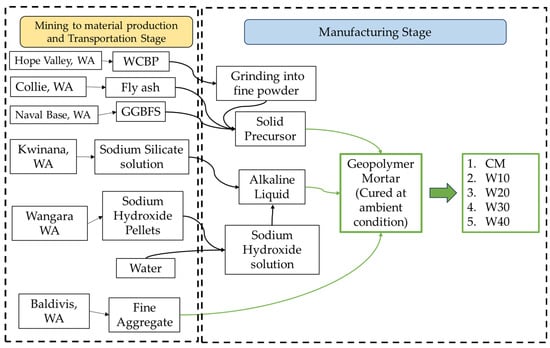
Figure 1.
System boundary for conducting the LCA of 1 cubic meter of a geopolymer mortar.
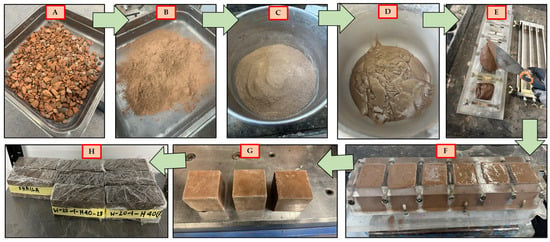
Figure 2.
Manufacturing and curing process of WCBP-based geopolymer mortar (W40) ((A) Brick aggregate; (B) WCBP; (C) dry mixing; (D) geopolymer mortar mix; (E) pouring the mortar mix into mold; (F) after finishing casting; (G) 50 mm cube mortar sample after demolding; (H) curing).
In this LCA investigation, a compressive strength of 1 MPa was selected as the functional unit to identify the geopolymer mixture that could deliver the greatest strength in an eco-efficient manner. The research used the Simapro (version 9.2) LCA software that can compute environmental impacts for every cubic meter (m3) of a geopolymer mortar. As a result, the environmental impacts were initially assessed for a 1 m3 mortar mix. Subsequently, these impact values were divided by the corresponding 28-day compressive strength value. The selected unit for estimating emissions and economic factors in transportation stage was the t-km (ton—kilometer). This unit accounts for the effects of weight on material transport and processing, in addition to the transport distance. The reliable databases for the t-km measurements are readily available in the SimaPro (version 9.2) software, and t-km is the standard unit for impact measurement in LCA software. A distinct profile was established for WCBP, considering the energy required for grinding the raw material into a suitable solid precursor.
2.2. Life Cycle Inventory (LCI) Analysis
Developing an LCI is a necessary step prior to assessing the environmental consequences. The LCI is generated using data from the author’s earlier research [37], which involved the assessment of the mechanical properties of the geopolymer mortar mixes. Table 1 presents the inventory analysis necessary for assessing the environmental impact of each mortar mix. This inventory includes raw materials such as fly ash, WCBP, GGBFS, sand, sodium silicate, sodium hydroxide, electricity used for manufacturing mortar samples, and transportation for the five different mortar mixes. It also specifies the source of material procurement. Curtin University was the site for manufacturing the geopolymer mortars. The transportation distance for different construction materials was between Curtin and the origins of these materials. The amount of WCBP differed in every trial, as the objective was to evaluate and contrast the mechanical properties of individual sample with varying proportions of WCBP.

Table 1.
Life cycle inventory of geopolymer mortar samples (mix proportions taken from Sharmin et al. [37].)
2.3. Life Cycle Impact Assessment (LCIA)
The data derived from the inventory analysis for each mortar mix were manually input into the SimaPro 9.2 LCA software. Subsequently, these input values were linked to the appropriate emission factor database. In most cases, the emission database from Western Australia was utilized for the inputs to accurately reflect the local environmental conditions. Distinct profiles were established for each unique geopolymer mortar mix, each accounting for its specific environmental impacts stemming from mining, transportation, and the construction stage. A novel database specific to WCBP was developed from the experimental work conducted by the authors at Curtin University for inclusion in the Simapro (version 9.2) software. This database was based on the data on energy consumption during the process of crushing brick pellets (i.e., to 0.2 kilowatt-hours per kilogram of waste brick aggregate crushed). Since all of these inputs cannot be calculated using an Australian input method, this prompted the use of SimaPro 9.2 with the methods recommended by Bengtsson and Howard [38] and Renouf et al. [39] for this study. Four distinct impact evaluation techniques specified in Table 2 were employed to assess the valuation of fourteen environmental impacts.

Table 2.
Impact category to evaluate environmental impact.
2.4. Life Cycle Cost Analysis
Utilizing the identical inventory evaluation, an economic assessment was conducted to ascertain the unit cost for five mortar mixtures. Consistency between economic and environmental evaluations was maintained by using the same functional unit as in the life cycle assessment, expressed in Australian dollars per megapascal of compressive strength (AUD/MPa).
The cost data in Table 3 represent the prices of raw materials for producing geopolymer mortars. These costs are based on prevailing market prices in the local market of Western Australia. WCBP was directly sourced from the regional supplier “Red Sand Supplies”, situated at 192 Hope Valley Road, Hope Valley, Western Australia 6165, known for specializing in recycled materials.

Table 3.
Prices of raw materials.
The cost of transportation was approximated at AUD 0.09 per ton–kilometer for road freight in accordance with the details provided by the Australian Government Department of Infrastructure and Regional Development [40]. The electricity cost during the manufacturing process was derived from publicly accessible information published on the Synergy website [41]. It was assumed that the electricity tariff corresponded to the Synergy business plan and was priced at 36.15 cents per unit (equivalent to 1 kWh) [41].
The total estimated life cycle cost for each of the mortar mixtures is presented in Table 4. This cost encompassed material costs, transportation expenses based on the t-km of materials in the LCI, and electricity costs for operating the mixing and compacting processes. It is worth noting that the labor costs were avoided as the author prepared these mixes as a part of their PhD project. The overall life cycle cost was subsequently divided by the corresponding compressive strength of the mixes to determine the cost in AUD per megapascal of compressive strength (AUD/MPa).

Table 4.
Total cost of 1 m3 geopolymer mortar sample.
2.5. Techno-Eco-Efficiency Framework
Portfolio analysis is involved in the development of environmental and economical portfolios of structurally and technically sound mixes. This techno-eco efficiency combined the effects of both the economic and the environmental values to ascertain the eco-efficiency portfolio positions of technically sound mortar mixes in this study. To standardize the environmental impact data acquired from the Simapro software, it was necessary to normalize these impacts by dividing them by the corresponding impact values for a particular region. The normalized values of the impacts were multiplied by the corresponding weights to transform all impacts to the same unit (i.e., ‘inhabitant equivalents’) in order to combine them and achieve a unified environmental score for each mortar mix [42]. This study utilized the environmental impacts of Australia’s gross domestic product (GDEI) (Bengtsson and Howard) [38] and corresponding weighting factors (WF) (Biswas) [42], as outlined in Table 5, to convert all impact values to a common unit, i.e., per inhabitant equivalent.

Table 5.
The gross domestic environmental impact and weighting factor for environmental impact.
The normalized value () for each environmental impact of every geopolymer mortar mixture (g) was determined using Equation (1), where is the environment impact values from the SimaPro software and is the gross domestic environmental impact in terms of the amount of impact per Australian inhabitant per year.
The normalized values for all environmental indicators were combined by applying an Australian weighting factor that reflects the significance of each environmental impact under Australian conditions and was incorporated using Equation (2). Here, is the normalized environmental impact for each geopolymer mix and is the weighting factor.
Much like the normalization process for environmental impacts, the overall life cycle costs associated with every mix were adjusted via the most recent Australian gross domestic product (Table 4). This adjustment allowed the presentation of costs in terms of the number of inhabitants generating an equivalent GDP per year [43]. is the life cycle cost for each geopolymer mix. The normalized cost () was articulated as the number of Australian inhabitants generating an equivalent annual GDP (GDPcap), as indicated by Equation (3) [44].
The author used a Shimadzu 300 kN Universal Testing Machine (Shimadzu Corporation, Kyoto, Japan) to conduct compressive strength tests on 28-day ambient cured geopolymer mortar samples (50 mm × 50 mm cubes) in accordance with ASTM C1437 [45]. The normalized environmental impact and cost were divided by the corresponding compressive strength values to derive the figures in relation to MPa.
The preliminary portfolio position environmental (PPe,g) and economic (PPc,g) impacts for the geopolymer mixes “g” were determined by comparing their normalized cost and environmental impact values against the average normalized values of cost and impact of geopolymer mixes using Equations (4) and (5) [44].
The calculated portfolio positions were fine-tuned by applying the environmental-to-cost relevance factor () outlined in Equation (6). Its purpose was to ascertain whether cost or environmental impact holds more significance in determining the eco-efficiency of geopolymer mix. This determination involved comparing the average normalized environmental impacts against the average normalized costs.
Finally, the initial positions are enhanced by the relevance factor to attain a revised spot that strikes an equilibrium between environmental impacts and life cycle costs, as depicted in Equations (7) and (8) [44].
Figure 3 illustrates a two-dimensional diagram depicting the normalized costs and environmental impacts for eco-efficiency analysis. This depiction is commonly referred to as the eco-efficiency portfolio. The horizontal axis represents normalized costs, while the vertical axis corresponds to environmental impacts. The scale ranges from the lowest numbers indicating the lowest impact and least cost to the highest numbers representing the highest impact and the highest cost values. The utmost eco-efficient option is identified by its space above the diagonal line, with the mix farthest from this diagonal line representing the most eco-efficient mix (Kicherer et al.) [44].
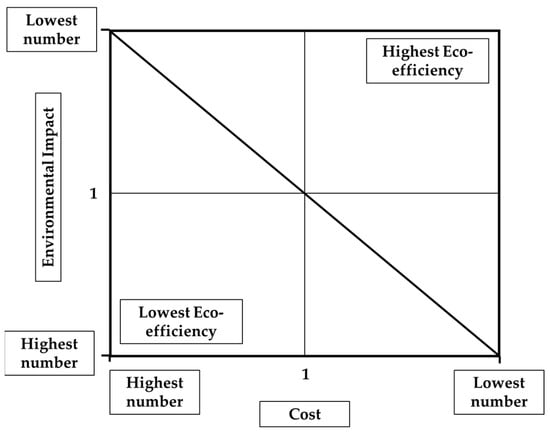
Figure 3.
Eco-efficiency portfolio developed by Kicherer et al. [44].
This study used emission factors derived from both local and foreign databases for construction materials, which could affect the accuracy of LCA results to some extent. To address these uncertainties, a Monte Carlo simulation (MCS) was performed based on Clavreul’s approach [46] to analyze uncertainties for each data point and forecast their influence on the LCA outputs for geopolymer mixes. The simulation process was performed for 1000 iterations for a confidence level of 95% [47].
3. Results and Discussion
3.1. Environmental Impact Analysis of Geopolymer Mortar Mix
Figure 4 illustrates the environmental impact analysis of five geopolymer mortar mixes in terms of the per inhabitant equivalent. The environmental impact is most pronounced in geopolymer mixes featuring 40% WCBP, followed by those with 30%, 20%, and 10% WCBP, as well as the CM mix, in that order. To provide specific percentages, the W40 sample exhibited a 1.7% higher environmental impact compared to the CM mix, W30 showed a 1.17% increase, W20 displayed a 0.69% rise, and W10 demonstrated a 0.31% increment.
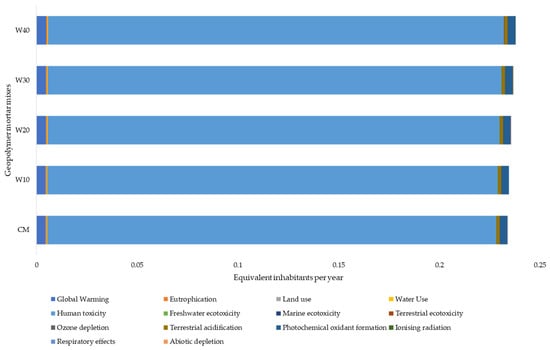
Figure 4.
Environmental impacts per inhabitant equivalent of geopolymer mortar mixes.
Human toxicity emerged as the primary environmental impact, making up almost 95% of the overall impact across all geopolymer mixes. Subsequently, global warming constituted the second significant impact, contributing only about 2% to the total impact. The heightened inclusion of WCBP in geopolymer synthesis resulted in increased levels of both human toxicity and global warming impact. Specifically, the W40 sample demonstrated a 1.56% higher impact on human toxicity than the CM mix, while W30 showed a 1.07% difference, W20 indicated a 0.64% distinction, and W10 presented a 0.28% variation. Additionally, concerning global warming impact, the W40 sample exceeded that of the CM mix by 6.44%, with W30 showing a 4.55% difference, W20 indicating a 2.84% distinction, and W10 presenting a 1.32% variation.
Dynan et al. [35] also identified human toxicity as the dominant environmental impact category while performing LCA on geopolymer concrete using recycled glass aggregates. Li et al. [48] studied fly ash-based geopolymer concrete and observed that opting for fly ash geopolymer concrete over conventional alternatives can lead to a reduction in carbon emissions. However, this shift may result in an increase in other environmental impacts, specifically energy depletion in their specific scenario. Nikravan et al. [49] stated that alkali-activated geopolymer mixtures contributed to significant reductions in carbon emissions, although there were higher values in other environmental impact categories such as “marine eco-toxicity” and “ozone layer depletion”.
In summary, substituting the conventional binder with the eco-friendly option in geopolymer binders has the potential to lower carbon dioxide emissions. However, this shift may lead to a significant increase in other environmental impacts due to the use of alkaline activators or grinding. Sbahieh et al. [50] confirmed that the geopolymer concrete has lower carbon emissions compared to OPC concrete during manufacturing, yet it presents minor adverse environmental effects, including abiotic depletion, human toxicity, freshwater ecotoxicity, terrestrial ecotoxicity, and acidification.
3.2. Hot-Spot Analysis
Figure 5 presents the flow network diagram for energy consumption for the CM and W40, created by SimaPro software. This flow network helps to identify the hotspots for each geopolymer mortar mix. In the case of the CM cured under ambient conditions, the mining to material stage was identified as the primary hotspot. This phase constituted 95.5% of the total energy consumption. Within this, 82.2% of the energy consumption was attributed to sodium silicate production at the batching plant, with an additional 9.04% stemming from sodium hydroxide production. In the case of the W40 mix, featuring a high WCBP content, 8.21% of the energy was consumed in grinding brick aggregate into WCBP. Subsequently, energy consumption was distributed as follows: 76.8% in the production of sodium silicate and 8.9% in the production of sodium hydroxide, both at the batching plant.
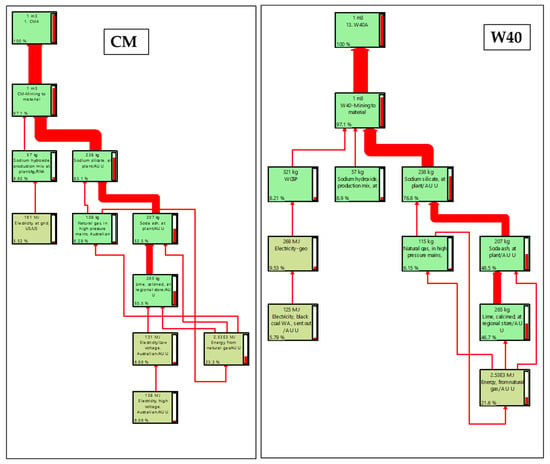
Figure 5.
Hotspot analysis of geopolymer mortar mixes (CM and W40—left to right).
The results of this study are comparable with other studies, as Miyan et al. [29] found that recycled waste concrete consistently reduced carbon emissions, cumulative energy demand, and costs, where alkaline solutions are a hotspot accounting for a significant portion of the impacts [29,35,50]. Therefore, Munir et al. [51] obtained industrial-based geopolymer concrete with an improved environmental performance using lower quantities of sodium silicate.
In summary, the noteworthy energy hotspot in both the CM and WCBP-rich mixes is the production of sodium silicate, followed by the production of sodium hydroxide. Furthermore, in WCBP-rich mixes, 5–8% of the energy is utilized in the preparation of WCBP.
3.3. Monte-Carlo Simulation
Figure 6 and Figure 7 depict the Monte Carlo analysis (MCA) of the major impact, “Human toxicity”, as identified through LCA analysis, specifically for CM and W40. Table 6 presents the mean values and coefficients of variation (CV) for dominant environmental impacts resulted from the geopolymer mixes. The CV ranges from 0.82% to 1.85% for the primary impact “Human toxicity”, suggesting that there is relatively low uncertainty in the calculated values for these impacts.

Figure 6.
Monte Carlo simulation for human toxicity for CM.

Figure 7.
Monte Carlo simulation for human toxicity for W40 mix.

Table 6.
Monte Carlo simulation outcome of LCA for three major impact categories in ambient cured geopolymer mixes.
3.4. LCC Analysis
Figure 8 and Figure 9 show the breakdown of LCC analysis for CM and W40 geopolymer mixes, respectively. In the study of the both CM and WCBP-rich sample, the cost analysis revealed that the costs of alkaline activator had the most significant influence, contributing to 95.9% and 97.6%, respectively, of the total material expenses. This cost was further broken down to identify the cost hotspot. Sodium silicate, constituting 48.56% of the cost for CM and 51.3% of the cost for W40, was identified as the hotspot, followed by sodium hydroxide (19.38% for CM and 20.47% for W40). The slightly elevated cost of fly ash is accountable for the increased expenses in the CM sample compared to the WCBP-rich samples.
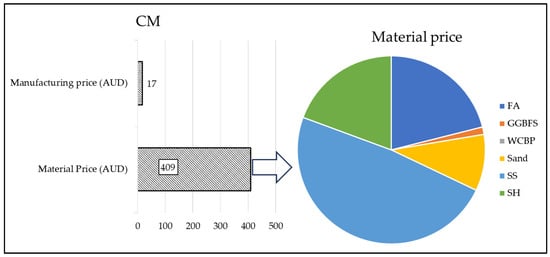
Figure 8.
Breakdown of LCC analysis of the CM geopolymer mix.
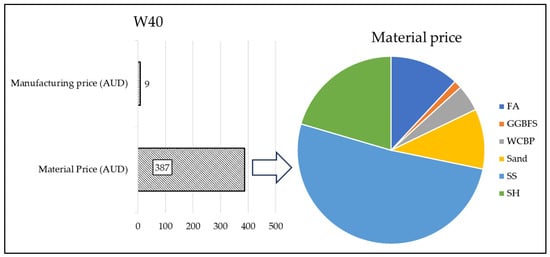
Figure 9.
Breakdown of LCC analysis of the W40 geopolymer mix.
The results of the current study are comparable with other studies, as alkaline activators have previously been found to be the economic hotspot. Singh et al. [52] also found that alkaline activators like sodium hydroxide and sodium silicate have the highest cost among all the raw materials used in geopolymer production. Fernando et al. [53] revealed that the use of alkaline activators accounted for 74% of the total initial cost for both fly ash geopolymer and blended alkali-activated concrete. Ramagiri et al. [54] showed that the contribution of alkaline activators to the total cost of the geopolymer binders ranged from 39.24% to 47.95%, highlighting that the absence of conventional activators in geopolymers leads to a cost-effective and environmentally sustainable mix. Therefore, this could affect the eco-efficiency performance of the geopolymer mixes, which is further investigated in Section 3.5.
To summarize, the expenditures associated with alkaline activators, specifically the prices of sodium silicate and sodium hydroxide, had the most significant impact on all geopolymer mixes.
3.5. Techno-Eco-Efficiency Analysis
Table 7 presents the 28-day compressive strength results sourced from the author’s previous study [37]. The compressive strength of each geopolymer mortar mix surpassed 40 MPa after a 28-day curing period, indicating their potential for use in structural applications. The geopolymer mortar mix incorporating 40% WCBP demonstrated the highest compressive strength among all the mixes. Following closely were the mixes containing 30%, 20%, and 10% WCBP and the control mix. This consistent trend strongly affirms the technical feasibility and effectiveness of employing WCBP as a solid precursor in the formulation of a geopolymer binder.

Table 7.
Compressive strength of geopolymer mortar mix [37].
The analysis began by normalizing the characterized values of the environmental impact for each geopolymer mix using Equations (1) and (2). These normalized values were then multiplied by the corresponding weights and then by the corresponding compressive strength values presented in Table 7 in order to obtain all environmental impact values in terms of compressive strength (MPa). Similarly, the life cycle cost was also subjected to normalization, following a specific equation (Equation (3)). The resulting normalized cost figures were then divided by the respective compressive strength values from Table 7. This division aimed to ascertain the cost value per unit of compressive strength (MPa). The findings are presented in Table 8, illustrating the normalized environmental impact value per MPa (EI/MPa) and the normalized life cycle cost value per MPa (Costs/MPa) for a 1 m cube of the geopolymer mortar mixture. Notably, the study observed a trend where the costs/MPa reduced as a proportion of WCBP in the geopolymer mix increased. This reduction was primarily attributed to the lower material price of WCBP. On the other hand, although WCBP-rich samples have a high environmental impact arising from the grinding process, the EI/MPa exhibited a decrease with a higher content of WCBP in the mix. This decrease was due to the high compressive strength of WCBP-rich samples than the control one.

Table 8.
Techno-eco-efficiency outcome of 1 m3 geopolymer mixes.
The environmental to cost relevance factor, calculated as 0.000573 (which is less than 1), suggests that the financial cost outweighs the environmental impact in the analysis [43]. Following the calculation of initial portfolios (PPe,g and PPc,g) using Equations (4) and (5), the refined portfolio positions (PP’e,g and PP’c,g) were determined using the environment to cost relevance factor through Equations (7) and (8).
Subsequently, Figure 10 illustrates the techno-eco-efficiency portfolio for geopolymer mortar mixes. According to the portfolio analysis, W20, W30, and W40 geopolymer mixes exhibited techno-eco-efficiency, while CM and W10 samples are deemed not technologically and economically efficient. Despite the higher environmental impact observed in WCBP-rich samples outlined in Section 3.1, the EI/MPa values declined with an increasing WCBP percentage in geopolymer mortar mixes, owing to their elevated compressive strength. For instance, the W40 sample exhibits a total normalized environmental impact of 0.24 with a compressive strength of 91.87 MPa, while the CM has a total normalized environmental impact of 0.23 with a compressive strength of 72.38 MPa. Consequently, the EI/MPa value for CM is greater than that of the W40 sample.
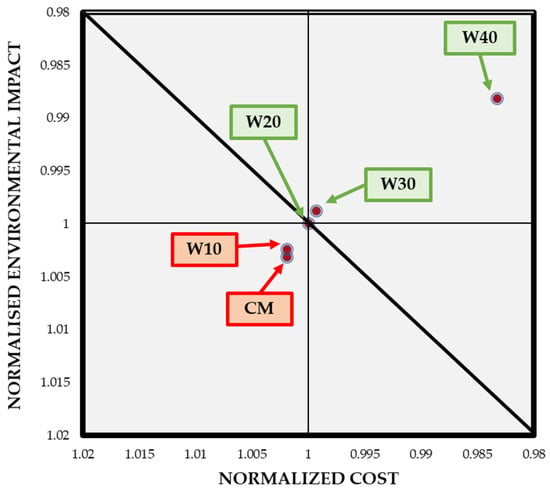
Figure 10.
Techno eco-efficiency portfolio for geopolymer mixes.
The comparison between the W40 sample and the CM sample reveals a decrease in the EI/MPa value, dropping from 0.0032 to 0.0025. This indicates a favorable environmental impact per unit of compressive strength for the W40 sample. Additionally, the WCBP-rich samples exhibit lower costs (AUD)/MPa values due to their economical material pricing. Consequently, the PP’e,g and PP’c,g values surpass 1 for the CM and W10 samples, suggesting higher environmental and cost impacts. In contrast, the W20, W30, and W40 samples boast values below 1 for both indicators, establishing them as superior performers among the five mixes in terms of the environmental impact and cost-effectiveness.
4. Conclusions
This study was undertaken to assess the techno-eco-efficiency of WCBP-based geopolymer mortars, particularly focusing on the substitution of fly ash with WCBP in ambient cured conditions. The environmental impact was higher for the WCBP-rich sample (up to a maximum of 1.7% for W40) compared to the CM containing 0% WCBP. Among the fourteen impacts studied, human toxicity emerged as the dominant environmental impact, accounting for around 95% of the impact across all the mixes, followed by global warming at 2%. Similar outcomes have been demonstrated in prior studies on glass aggregate-based geopolymer concrete [35].
Next, the primary area of concern was pinpointed, specifically the energy utilized in the production of alkaline activators at the batching plant, which emerged as a significant factor across all geopolymer mixes. Simultaneously, the activity of grinding brick aggregate into WCBP consistently stood out as a crucial hotspot in the geopolymer mortar mixes that incorporated WCBP. These findings emphasize the critical role of these processes in the overall energy consumption and environmental impact of geopolymer production. Prior research has demonstrated analogous findings for alkali-activated geopolymer mix [33].
In the case of LCC, the examination revealed that the greatest cost contributor for all geopolymer mortar samples was associated with alkaline activators, specifically sodium silicate and sodium hydroxide. These components stood out as the primary factors influencing the economic aspects of the geopolymer production process. Furthermore, in the case of WCBP-rich samples, the total cost was found to be lower than that of the CM. This cost reduction is attributed to the economical pricing of WCBP, signifying its potential as a cost-effective alternative in the formulation of geopolymer mortars.
Eventually, the geopolymer mixes enriched with WCBP—namely W40, W30, and W20—were recognized as technologically and economically efficient (techno-eco-efficient). This designation is attributed to their favorable combination of higher compressive strength and lower costs. On the contrary, both the CM and W10 mixes were not considered eco-efficient due to their lower compressive strength and higher associated costs. This conclusion underscores the importance of both mechanical performance and economic considerations in determining the overall efficiency of geopolymer mixes. Future studies should integrate solutions to treat the hotspots to further enhance the techno-eco-efficiency of geopolymer mixes.
Author Contributions
Conceptualization, methodology, formal analysis, investigation, and writing—original draft preparation, S.S.; Conceptualization, methodology, resources, supervision and writing—review and editing, W.K.B.; Conceptualization, methodology, resources, supervision and writing—review and editing, P.K.S. All authors have read and agreed to the published version of the manuscript.
Funding
This research received no external funding.
Data Availability Statement
The raw data supporting the conclusions of this article will be made available by the authors on request.
Conflicts of Interest
The authors declare no conflicts of interest.
References
- Sousa, V.; Bogas, J.A.; Real, S.; Meireles, I. Industrial Production of Recycled Cement: Energy Consumption and Carbon Dioxide Emission Estimation. Environ. Sci. Pollut. Res. 2023, 30, 8778–8789. [Google Scholar] [CrossRef] [PubMed]
- USGS. Cement Statistics and Information. 2021. Available online: https://www.Usgs.Gov/Centers/National-Minerals-Information-Center/Cement-Statistics-and-Information (accessed on 12 November 2023).
- Pacheco-Torgal, F.; Castro-Gomes, J.; Jalali, S. Alkali-Activated Binders: A Review. Part 1. Historical Background, Terminology, Reaction Mechanisms and Hydration Products. Constr. Build. Mater. 2008, 22, 1305–1314. [Google Scholar] [CrossRef]
- Davidovits, J. Geopolymers: Inorganic geopolymeric new materials. J. Therm. Anal. 1991, 37, 1633–1656. [Google Scholar] [CrossRef]
- Hardjito, D. Studies on Fly Ash-Based Geopolymer Concrete. PhD Thesis, Curtin University of Technology, Perth, Australia, 2005. [Google Scholar]
- Nath, P.; Sarker, P.K. Effect of GGBFS on Setting, Workability and Early Strength Properties of Fly Ash Geopolymer Concrete Cured in Ambient Condition. Constr. Build. Mater. 2014, 66, 163–171. [Google Scholar] [CrossRef]
- Tian, X.; An, C.; Chen, Z. The Role of Clean Energy in Achieving Decarbonization of Electricity Generation, Transportation, and Heating Sectors by 2050: A Meta-Analysis Review. Renew. Sustain. Energy Rev. 2023, 182, 113404. [Google Scholar] [CrossRef]
- Ghorbani, S.; Stefanini, L.; Sun, Y.; Walkley, B.; Provis, J.L.; De Schutter, G.; Matthys, S. Characterisation of Alkali-Activated Stainless Steel Slag and Blast-Furnace Slag Cements. Cem. Concr. Compos. 2023, 143, 105230. [Google Scholar] [CrossRef]
- Robayo-Salazar, R.A.; Rivera, J.F.; Mejía de Gutiérrez, R. Alkali-Activated Building Materials Made with Recycled Construction and Demolition Wastes. Constr. Build. Mater. 2017, 149, 130–138. [Google Scholar] [CrossRef]
- Wu, H.; Zuo, J.; Yuan, H.; Zillante, G.; Wang, J. Investigation of the Social and Economic Impacts of Cross-Regional Mobility of Construction and Demolition Waste in Australia. Resour. Conserv. Recycl. 2023, 190, 106814. [Google Scholar] [CrossRef]
- Australian Bureau of Statistics. Waste Account, Australia, Experimental Estimates 2018-19 Financial Year. Available online: https://www.abs.gov.au/statistics/environment/environmental-management/waste-account-australia-experimental-estimates/latest-release (accessed on 12 November 2023).
- He, Z.; Shen, A.; Wu, H.; Wang, W.; Wang, L.; Yao, C.; Wu, J. Research Progress on Recycled Clay Brick Waste as an Alternative to Cement for Sustainable Construction Materials. Constr. Build. Mater. 2021, 274, 122113. [Google Scholar] [CrossRef]
- De Silva, P.; Sagoe-Crenstil, K.; Sirivivatnanon, V. Kinetics of Geopolymerization: Role of Al2O3 and SiO2. Cem. Concr. Res. 2007, 37, 512–518. [Google Scholar] [CrossRef]
- Reig, L.; Tashima, M.M.; Borrachero, M.V.; Monzó, J.; Cheeseman, C.R.; Payá, J. Properties and Microstructure of Alkali-Activated Red Clay Brick Waste. Constr. Build. Mater. 2013, 43, 98–106. [Google Scholar] [CrossRef]
- Ouda, A.S.; Gharieb, M. Development the Properties of Brick Geopolymer Pastes Using Concrete Waste Incorporating Dolomite Aggregate. J. Build. Eng. 2020, 27, 100919. [Google Scholar] [CrossRef]
- Migunthanna, J.; Rajeev, P.; Sanjayan, J. Waste Clay Bricks as a Geopolymer Binder for Pavement Construction. Sustainability 2022, 14, 6456. [Google Scholar] [CrossRef]
- Salas, D.A.; Ramirez, A.D.; Ulloa, N.; Baykara, H.; Boero, A.J. Life Cycle Assessment of Geopolymer Concrete. Constr. Build. Mater. 2018, 190, 170–177. [Google Scholar] [CrossRef]
- Kastiukas, G.; Ruan, S.; Liang, S.; Zhou, X. Development of Precast Geopolymer Concrete via Oven and Microwave Radiation Curing with an Environmental Assessment. J. Clean. Prod. 2020, 255, 120290. [Google Scholar] [CrossRef]
- Kul, A.; Ozel, B.F.; Ozcelikci, E.; Gunal, M.F.; Ulugol, H.; Yildirim, G.; Sahmaran, M. Characterization and Life Cycle Assessment of Geopolymer Mortars with Masonry Units and Recycled Concrete Aggregates Assorted from Construction and Demolition Waste. J. Build. Eng. 2023, 78, 107546. [Google Scholar] [CrossRef]
- Yoris-Nobile, A.I.; Lizasoain-Arteaga, E.; Slebi-Acevedo, C.J.; Blanco-Fernandez, E.; Alonso-Cañon, S.; Indacoechea-Vega, I.; Castro-Fresno, D. Life Cycle Assessment (LCA) and Multi-Criteria Decision-Making (MCDM) Analysis to Determine the Performance of 3D Printed Cement Mortars and Geopolymers. J. Sustain. Cem. Based Mater. 2023, 12, 609–626. [Google Scholar] [CrossRef]
- Bajpai, R.; Choudhary, K.; Srivastava, A.; Sangwan, K.S.; Singh, M. Environmental Impact Assessment of Fly Ash and Silica Fume Based Geopolymer Concrete. J. Clean. Prod. 2020, 254, 120147. [Google Scholar] [CrossRef]
- Abbas, R.; Khereby, M.A.; Ghorab, H.Y.; Elkhoshkhany, N. Preparation of Geopolymer Concrete Using Egyptian Kaolin Clay and the Study of Its Environmental Effects and Economic Cost. Clean. Technol. Environ. Policy 2020, 22, 669–687. [Google Scholar] [CrossRef]
- Janjua, S.Y.; Sarker, P.K.; Biswas, W.K. A Review of Residential Buildings’ Sustainability Performance Using a Life Cycle Assessment Approach. J. Sustain. Res. 2019, 1, e190006. [Google Scholar]
- Amari, S.; Darestani, M.; Millar, G.J.; Samali, B.; Strounina, E. Engineering and Life Cycle Assessment (LCA) of Sustainable Zeolite-Based Geopolymer Incorporating Blast Furnace Slag. Sustainability 2024, 16, 440. [Google Scholar] [CrossRef]
- Gopalakrishna, B.; Dinakar, P. Life Cycle Assessment (LCA) and the Influence of Alkaline Activator Content on Mechanical and Microstructural Properties of Geopolymer Mortar. J. Eng. Res. 2024, in press. [Google Scholar] [CrossRef]
- Raza, M.H.; Khan, M.; Zhong, R.Y. Strength, Porosity and Life Cycle Analysis of Geopolymer and Hybrid Cement Mortars for Sustainable Construction. Sci. Total Environ. 2024, 907, 167839. [Google Scholar] [CrossRef] [PubMed]
- Gopalakrishna, B.; Pasla, D. Durability Performance of Recycled Aggregate Geopolymer Concrete Incorporating Fly Ash and Ground Granulated Blast Furnace Slag. J. Mater. Civ. Eng. 2024, 36, 04024037. [Google Scholar] [CrossRef]
- Ricciotti, L.; Occhicone, A.; Ferone, C.; Cioffi, R.; Roviello, G. Eco-Design of Geopolymer-Based Materials Recycling Porcelain Stoneware Wastes: A Life Cycle Assessment Study. Environ. Dev. Sustain. 2023, 26, 4055–4074. [Google Scholar] [CrossRef]
- Miyan, N.; Omur, T.; Amed, B.; Özkan, H.; Aydın, R.; Kabay, N. Recycled Waste Concrete and Metakaolin Based Alkali-Activated Paste: Characterization, Optimization, and Life Cycle Assessment. Constr. Build. Mater. 2024, 416, 135233. [Google Scholar] [CrossRef]
- Occhicone, A.; Graziuso, S.G.; De Gregorio, E.; Montagnaro, F.; Ricciotti, L.; Tarallo, O.; Roviello, G.; Ferone, C. Synthesis and Characterization of New Acid-Activated Red Mud-Metakaolin Geopolymers and Comparison with Their Alkaline Counterparts. J. Clean. Prod. 2024, 435, 140492. [Google Scholar] [CrossRef]
- Migunthanna, J.; Manjunatha, N.T.; Shatagar, V.G.; Raghu, D.H.; Zinzala, R.S.; Rajeev, P.; Sanjayan, J. Simplified Life Cycle Analysis for Rigid Pavements Constructed Using Waste Materials as Binders in Concrete. Int. J. Stud. Proj. Report. 2022, 1, 143–165. [Google Scholar] [CrossRef]
- Mir, N.; Khan, S.A.; Kul, A.; Sahin, O.; Lachemi, M.; Sahmaran, M.; Koç, M. Life Cycle Assessment of Binary Recycled Ceramic Tile and Recycled Brick Waste-Based Geopolymers. Clean. Mater. 2022, 5, 100116. [Google Scholar] [CrossRef]
- Fořt, J.; Mildner, M.; Keppert, M.; Pommer, V.; Černý, R. Experimental and Environmental Analysis of High-Strength Geopolymer Based on Waste Bricks and Blast Furnace Slag. Polymers 2023, 15, 3092. [Google Scholar] [CrossRef]
- ISO 14040-44:2006; Environmental Management—Life Cycle Assessment—Principles and Framework. ISO: Geneva, Switzerland, 2006.
- Dynan, D.; Shaikh, F.; Derry, S.; Biswas, W.K. Eco-Efficiency Assessment Utilizing Recycled Glass Aggregate in Concrete. Buildings 2023, 13, 910. [Google Scholar] [CrossRef]
- ASTM C618-23e1; Standard Specification for Coal Ash and Raw or Calcined Natural Pozzolan for Use in Concrete. ASTM: West Conshohocken, PA, USA, 2023. [CrossRef]
- Sharmin, S.; Sarker, P.K.; Biswas, W.K.; Abousnina, R.M.; Javed, U. Characterization of Waste Clay Brick Powder and Its Effect on the Mechanical Properties and Microstructure of Geopolymer Mortar. Constr. Build. Mater. 2024, 412, 134848. [Google Scholar] [CrossRef]
- Bengtsson, J.H.N. A Life Cycle Impact Assessment Method; Part 2: Normalisation; Building Products Innovation Council: Engadine, Australia, 2010. [Google Scholar]
- Renouf, M.A. Best Practice Guide for Life Cycle Impact Assessment (LCIA) in Australia; Australian Life Cycle Assessment Society: Gold Coast, Australia, 2015. [Google Scholar]
- Department of Infrastructure and Regional Development. International Comparison of Australia’s Freight and Supply Chain Performance. 2019. Available online: https://www.freightaustralia.gov.au/sites/default/files/documents/international-comparison-of-australias-freight-and-supply-chain-performance.pdf (accessed on 12 November 2023).
- Synergy. Synergy-Price-Changes. 2022. Available online: https://www.Synergy.Net.Au/Global/Synergy-Price-Changes-2022 (accessed on 12 November 2023).
- Biswas, W.K. Carbon Footprint and Embodied Energy Consumption Assessment of Building Construction Works in Western Australia. Int. J. Sustain. Built Environ. 2014, 3, 179–186. [Google Scholar] [CrossRef]
- Arceo, A.; Rosano, M.; Biswas, W.K. Eco-Efficiency Analysis for Remote Area Power Supply Selection in Western Australia. Clean. Technol. Environ. Policy 2018, 20, 463–475. [Google Scholar] [CrossRef]
- Kicherer, A.; Schaltegger, S.; Tschochohei, H.; Pozo, B.F. Eco-Efficiency: Combining Life Cycle Assessment and Life Cycle Costs via Normalization. Int. J. Life Cycle Assess. 2007, 12, 537–543. [Google Scholar] [CrossRef]
- ASTM C109/C109M-21; Standard Test Method for Compressive Strength of Hydraulic Cement Mortars (Using 2-in. or [50 Mm] Cube Specimens). ASTM: West Conshohocken, PA, USA, 2024. [CrossRef]
- Clavreul, J.; Guyonnet, D.; Christensen, T.H. Quantifying Uncertainty in LCA-Modelling of Waste Management Systems. Waste Manag. 2012, 32, 2482–2495. [Google Scholar] [CrossRef] [PubMed]
- Uddin, F.; Shaikh, A.; Hosan, A.; Biswas, W.K. Sustainability assessment of reinforced concrete beam mixes containing recycled aggregates and industrial by-products. J. Green Build. 2020, 15, 95–119. [Google Scholar]
- Li, Y.; Shi, X.; Feng, Y.; Su, Y.; Zhang, Y.; Pu, Y.; Wang, Q. A Novel Multi-Criteria Comprehensive Evaluation Model of Fly Ash-Based Geopolymer Concrete. Constr. Build. Mater. 2023, 396, 132253. [Google Scholar] [CrossRef]
- Nikravan, M.; Firdous, R.; Stephan, D. Life Cycle Assessment of Alkali-Activated Materials: A Systematic Literature Review. Low-Carbon. Mater. Green. Constr. 2023, 1, 13. [Google Scholar] [CrossRef]
- Sbahieh, S.; McKay, G.; Al-Ghamdi, S.G. Comprehensive Analysis of Geopolymer Materials: Properties, Environmental Impacts, and Applications. Materials 2023, 16, 7363. [Google Scholar] [CrossRef]
- Munir, Q.; Abdulkareem, M.; Horttanainen, M.; Kärki, T. A Comparative Cradle-to-Gate Life Cycle Assessment of Geopolymer Concrete Produced from Industrial Side Streams in Comparison with Traditional Concrete. Sci. Total Environ. 2023, 865, 161230. [Google Scholar] [CrossRef] [PubMed]
- Singh, S.K.; Badkul, A.; Pal, B. Sustainable Next-Generation Single-Component Geopolymer Binders: A Review of Mechano-Chemical Behaviour and Life-Cycle Cost Analysis. J. Mater. Cycles Waste Manag. 2023, 26, 49–75. [Google Scholar] [CrossRef]
- Fernando, S.; Gunasekara, C.; Law, D.W.; Nasvi, M.C.M.; Setunge, S.; Dissanayake, R. Life Cycle Assessment and Cost Analysis of Fly Ash–Rice Husk Ash Blended Alkali-Activated Concrete. J. Environ. Manag. 2021, 295, 113140. [Google Scholar] [CrossRef] [PubMed]
- Ramagiri, K.K.; Kar, A. Environmental Impact Assessment of Alkali-Activated Mortar with Waste Precursors and Activators. J. Build. Eng. 2021, 44, 103391. [Google Scholar] [CrossRef]
Disclaimer/Publisher’s Note: The statements, opinions and data contained in all publications are solely those of the individual author(s) and contributor(s) and not of MDPI and/or the editor(s). MDPI and/or the editor(s) disclaim responsibility for any injury to people or property resulting from any ideas, methods, instructions or products referred to in the content. |
© 2024 by the authors. Licensee MDPI, Basel, Switzerland. This article is an open access article distributed under the terms and conditions of the Creative Commons Attribution (CC BY) license (https://creativecommons.org/licenses/by/4.0/).